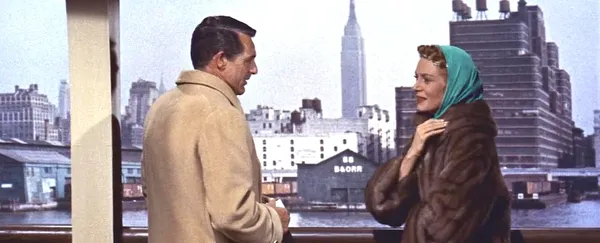 |
| James Sanders in Celluloid Skyline: New York And The Movies quotes Deborah Kerr with Cary Grant in Leo McCarey’s An Affair To Remember: “It’s the nearest thing to heaven we have in New York.” |
In the first instalment with architect, author, and filmmaker James Sanders, we discuss his timeless and profound book, Celluloid Skyline: New York And The Movies, in which he explores how deeply one informs the other. From Joan Didion’s wisdom to Cedric Gibbons’s dream sets in the sky, we touch on George Stevens’s Swing Time (starring Fred Astaire and Ginger Rogers) and Robert Z Leonard’s Susan Lenox (with Greta Garbo and Clark Gable); East River running with Jill Clayburgh and Michael Murphy in Paul Mazursky’s An Unmarried Woman.
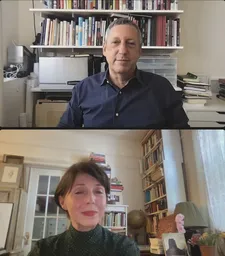 |
| James Sanders with Anne-Katrin Titze: “One of the aspects of a mythic city is that it can go anywhere ” |
The mansion in George Cukor’s Holiday giving Katharine Hepburn and Cary Grant the chance to represent the departure of the 19th century; Howard Hawks’s Ball Of Fire (co-written by Billy Wilder and Charles Brackett, starring Barbara Stanwyck and Gary Cooper) and the end of an army of staff; The Dakota, the Alwyn Court and Roman Polanski scouting with Richard Sylbert for Rosemary’s Baby; New York, a documentary film series with Ric Burns and our shared admiration and friendship with the great independent documentarian Nancy Buirski all came up and more.
Sanders is interested in the intersections where the representation on the screen and the city itself overlap. In his book he quotes, among others, Italo Calvino’s Invisible Cities, Jean Baudrillard on Italian and Dutch paintings, and Ray Bradbury on drama and theatre being “the stuff of living.” What is this city and what dreams come with it? There is an analysis of the establishing shot of William Dieterle’s Portrait of Jennie from 1948 and points about how F Scott Fitzgerald or Dorothy Parker’s nostalgia for the city while being stuck out West tinged their portrayals. It conjures thoughts about visions of the future or a mythological elsewhere in The Wizard Of Oz, the various King Kongs, or Luc Besson’s The Fifth Element. Science fictions always have a documentary quality to them, as Kleber Mendonça Filho makes so clear in his latest film, Pictures Of Ghosts, which is Brazil’s Oscar submission.
The set for the street scenes of William Wyler’s Dead End (1937), with a screenplay by Lillian Hellman, or Elia Kazan’s A Tree Grows In Brooklyn cannot be separated from the city’s building history. We learn from Sanders about a wide spectrum of facts - that the first housing project in the country was in Red Hook, Brooklyn in 1938 and about Hollywood’s admiration for the penthouse. The lost grandeur of bay windows in Otto Preminger’s Laura (1944), Rear Window realities, and “the place nearest to heaven” in Leo McCarey’s An Affair To Remember, Preminger’s The Moon Is Blue, and Gene Kelly and Stanley Donen’s On The Town all deserve a fresh look in the now. While also going to the edges On The Waterfront, all the way out to the Rockaways in Woody Allen’s Radio Days, or to the Hudson River Piers in Wilder’s Sabrina, Grand Central Terminal remains central as it is in Vincente Minnelli’s The Band Wagon for arrivals and Hitchcock’s North By Northwest for departures.
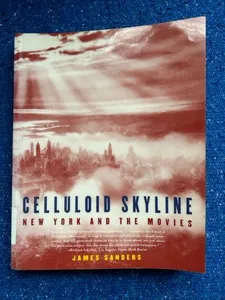 |
| Celluloid Skyline: New York And The Movies by James Sanders Photo: Anne-Katrin Titze |
Be it Dean Martin’s bachelor pad in Minnelli’s Bells Are Ringing, the apartment with a view in Fred Schepisi’s Six Degrees Of Separation, or the bookstore in Donen’s Funny Face, these are locations with a surplus. As Joan Didion so perfectly put it in the quote that sets the tone for Celluloid Skyline: “New York was no mere city. It was instead an infinitely romantic notion, the mysterious nexus of all love and money and power, the shining and perishable dream itself.”
The book launch at Rizzoli in New York for Renewing The Dream: The Mobility Revolution And The Future Of Los Angeles (Rizzoli Electa), edited by James Sanders, with a preface by Nik Karalis, and contributions by Frances Anderton and Donald Shoup and Mark Valliantos will take place on Friday, November 3 at 6:00pm.
From New York City, James Sanders joined me on Zoom for an in-depth conversation on Celluloid Skyline: New York And The Movies and many of the filmic locations in the book.
Anne-Katrin Titze: Hello!
James Sanders: Hello!
AKT: You begin Celluloid Skyline with two very interesting quotes. I love the Joan Didion one. I mean, I love the Melville quote, too [“It is not on any map; true places never are”], but Didion really reflects what you were doing with the book, that “New York was no mere city” but instead “an infinitely romantic notion … the shining” and then she uses a wonderfully accurate word, “perishable dream itself.” When did that quote come into this big project of yours?
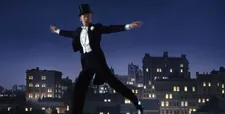 |
| Fred Astaire in The Belle Of New York, directed by Charles Walters |
JS: I wrote my book starting in the late 1980s and I can’t remember exactly when I came across it, but when I came across it I was like, whoa, she got it all; she understood everything I was trying to say. So I knew it was going to go with the front of the book. Then when 9/11 happened, other people discovered the quote. And of course that word 'perishable' suddenly seemed so brilliant and moving. Why would she use it back then? I believe it was from her essay Goodbye To All That.
She must have written it in the Seventies about her experience in New York in the 1960s when she lived here for a couple of years before moving back to LA. I thought it was just so apropos and so right to the idea that I was trying to get at. Which was that all these hundreds, thousands of movies were not offering a mirror to the city, although they were also doing that. But in my view, they conspired together collectively to create their own dream city, their own mythic city. That was the key conceit of the entire book.
AKT: And the connection to Hollywood! The dreaming of the dreaming of the city in the Garden of Allah!
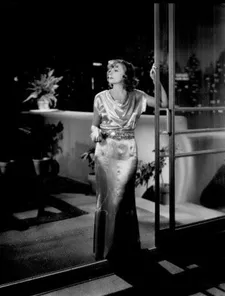 |
| Greta Garbo in Susan Lenox, directed by Robert Z Leonard |
JS: Yes exactly! Whereas people who are sort of parochial, if I may say that, about it, think that it’s more important that the films realistically are capturing the city, which they did in the 1910s and ’20s, when they filmed in the silent era in the streets of New York, because there was no reason not to. And then began to again in the late 1940s, picking up in the 1960s. I was fascinated by this extraordinary story. And when has this ever happened in history in which a city would effectively be rebuilt in another city? I thought that that was remarkable. When you build a city from scratch, so to speak, in the backlots and soundstages of Hollywood studios, every decision is a creative decision. There’s nothing given, there’s no donnée.
AKT: A Cedric Gibbons penthouse is the ultimate New York penthouse - the set he did for Susan Lenox is it! I think you call Swing Time the ultimate New York musical of all time. I can agree.
JS: I tried not to make cinematic judgements. Swing Time to me is not the ultimate New York musical. Maybe it is. It’s the ultimate rooftop musical! It’s the ultimate film at all about the potentiality of the tops of buildings, which of course New York did better than any other city in the world.
AKT: And nobody is better than Fred Astaire to encapsulate all that! I also remember The Belle of New York, a musical by Charles Walters that I haven’t seen forever, probably since there was an Arthur Freed retrospective in Paris in the Nineties. And he is flying over Washington Square Park. To stay with 'ultimates' - the ultimate East River jogging takes place in An Unmarried Woman, doesn’t it?
JS: Yes! As it happens, for me that was very personal, because that’s the little part of the world that I grew up in on the Upper East Side of Manhattan. And I used to myself walk often on that East River Esplanade or promenade that had been built in the 1940s when the FDR Drive was built. It’s all been rebuilt now and it’s quite beautiful, but when she’s running on it, it’s not a wreck, but by comparison to today, it’s definitely an unfinished place.
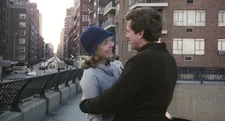 |
| Jill Clayburgh with Michael Murphy in An Unmarried Woman, directed by Paul Mazursky |
AKT: You just mentioned you grew up here, so you are not someone who came to New York from outside. I think for everybody who does come from elsewhere, it is movie images we have in our heads when we first arrive, and suddenly you see it is all here! I will forever remember visiting New York as a child with my parents and seeing the Flatiron for the first time, and my thoughts went immediately to Richard Quine’s Bell, Book, and Candle, which I had seen on TV. This is where Jimmy Stewart throws his hat down. There is a special energy in these moments that makes both the films and the reality bigger.
JS: One of the points I make is that movies can travel, a city cannot travel. You can come to it but it cannot come to you. One of the aspects of a mythic city is that it can go anywhere. Not only do people know it in some basic way, knowing the skyline or something like that, they’re moved by it. It touches them. New York is a moving presence for people all around the world, most of whom have never been here. How many cities in the world can you say that of? Not many. Paris, London.
AKT: Rome!
JS: Rome. You would say it of San Francisco, for example. What makes a city mythic and also powerful that people thousands of miles away are moved by it? People have noted that one of the things why 9/11 was so extraordinary an event was that it attacked a place that everybody felt was theirs. Not only, but in great part due to the movies, it was a personal attack. It was a place they knew and people they cared about. The people on the streets - these were streets that they had seen since they were children. I think you’re touching on something very profound about the whole relationship between city and film.
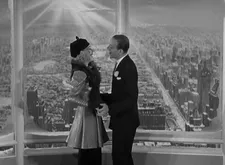 |
| Ginger Rogers with Fred Astaire in Swing Time, directed by George Stevens |
AKT: Especially the skyline is something that people think they own. You write about the texture of the set-back terraces which later disappears. I want to talk about some of the specifics. The impressive mansion in Holiday for instance. I never thought about this before reading your book - the mansion is treated like a dinosaur by Hollywood at the time. Maybe it was still too close? It is only the mansion in the city, though, because you have in the Thirties and Forties a romantic notion about the turn of the century and the Gilded Age. But it’s usually country life, as in Meet Me in St. Louis for example, a rural or small-town world that’s good. But not in the big city.
JS: I think that’s right. By the time the talkies came into the early Thirties, the mansion way-of-life was already on its way out. The great period of mansion building in New York has been from the 1890s to the 1900s. In 1913, the United States had instituted the Federal Income Tax. It’s hard to imagine now, but before 1913 you kept every dollar you made. Once you got the Income Tax it was harder and harder to sustain the mansions. Also the cost of labour went up. The secret of the mansions was that they could only operate with a small army of people who run them.
AKT: Servants.
JS: It wasn’t like a maid and cook, you needed about 30 people to run these places. So the stories in the 1930s were about old grand mansions on 5th Avenue being torn down. Other films talk about that, Ball Of Fire for example.
 |
| Mia Farrow in Rosemary's Baby, directed by Roman Polanski |
AKT: With the conga line [led by Barbara Stanwyck]!
JS: The conga line! But they’re told basically that as soon as the encyclopaedia is finished, the building’s coming down. There were a few families still living in the grand mansions, so the basis for Holiday was one of those and imagining the rebellious children. It’s evident to me that Katharine Hepburn and Cary Grant at the end of the movie on the steamship when they do finally get together and kiss, and they’re now going to have their life together, we don’t know what their life is going to be, but one thing we can say: They are not going to live in a mansion.
AKT: That life is over. They’re going to build a playroom somewhere else. Another building and film connection I want to talk about is The Dakota and Rosemary’s Baby. It was one of the first apartment buildings and I like how you explain the re-arrangements that took place. Only a location like this can have the story like Rosemary’s Baby, in a way. I thought about how in traditional narratives, in mythology, the devil cannot enter your home unless you invite him in. Only through the reshaping of the apartment spaces is the devil already there! Architecture connecting to ancient mythology!
JS: I think you’re now touching on what I think, if I may say, is the largest achievement of Celluloid Skyline. Which was figuring out that directors and screenwriters and everyone else involved in the production of films were telling you these stories, of course, and engaging you. They were doing also a whole other level of insight. They were anatomizing the built environments of New York. Just to go back to Holiday for a second - the staff and the family never interacted. The staff was behind the scenes to allow the life of the family to survive. The entire house was built around the isolation of the classes. So it’s Johnny, the modern figure, the 20th century American man who comes into this household.
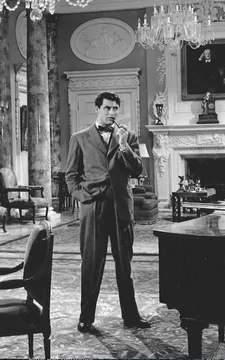 |
| Cary Grant in Holiday, directed by George Cukor |
AKT: Through the servants’ entrance!
JS: He comes in the wrong way! It tells you right there that this person is going to break the rules upon which the entire house has been built. The answer is in the very beautiful, powerful climactic scene, where Katharine Hepburn in the party looks for Johnny. She, for the first time in her life as an adult, crosses the isolation, she breaks the segregation. She has become a modern woman, too, and the 20th century has arrived. The 19th century is leaving. All this in a nice happy romantic comedy about a wealthy family!
AKT: It’s remarkable, that’s why the film stands the test of time.
JS: Now moving forward to Rosemary’s Baby, there was a real building, it was called the Alwyn Court and it had these enormous apartments, that had been built around 1900 or 1905. During the Depression, when those apartments were simply too big and too expensive, the developer, the builder, cut the apartments in two to make them more reasonably sized for newer families.
Again - giant societal changes are reflected in the built form of New York. No longer having these huge families - and these big apartments had a big staff, not as big as those mansions, but they may have three or four staff people, who are no longer needed. Modern families tended to be smaller than Victorian families. They cut the building in two and for years afterward, there were always strange stories of people hearing things. Inevitably, the cut part where they put up a wall, wasn’t that well-built as the rest of it, so people would hear the people on the other side of the newly-built wall. Thus arose the story that the building was haunted. Who knows, maybe it was really haunted!
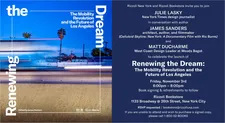 |
| Renewing The Dream: The Mobility Revolution And The Future Of Los Angeles |
That building was the source of the novel [by Ira Levin] of Rosemary’s Baby. But the Alwyn Court, beautiful as it is, didn’t carry the sheer power that is described. Richard Sylbert, the production designer, one of our greatest art directors of the 20th century, took Roman Polanski around the city to look at apartment houses as one of the first things to do. He said to Polanski, there’s one building you have to see! And Polanski, who didn’t know New York well, he was from Poland and maybe lived in LA for a while - they walked through Central Park and there it was! And it was, yes of course, that’s where we’re going to set it because it already looks like a haunted house!
AKT: Your book didn’t age one bit! Had I read it twenty years ago, I would have been as happy to read it as now!
JS: Oh thank you!
AKT: You also made a film series with Ric Burns?
JS: I was working on that simultaneously. It’s called New York: A Documentary Film. As it stands it’s an eight-part, 17-and-a-half-hour series that aired in three tranches. Five episodes in 1999, two more episodes in 2001 and then a final episode in 2003 about the World Trade Center. We basically worked on it from 1993 to 2003. We are now currently making two new episodes of the series, which will air likely at the end of next year.
 |
| James Stewart with Kim Novak in Bell, Book And Candle, directed by Richard Quine |
They’ll take the story from where we left off at the beginning of the rebuilding of the World Trade Center in 2002 or 2003 to today. It’ll go through the rebuilding of the city after 9/11, the financial crisis in 2008 and 2009, Superstorm Sandy in 2012, and of course the pandemic of the last several years. And in-between all the transformations that were going on in the city. That’ll be two new two-hour episodes.
AKT: Did you see Nancy Buirski’s Desperate Souls, Dark City And The Legend Of Midnight Cowboy?
JS: I have not yet. I knew Nancy well and I told her that I had written about the film, which she didn’t know about. She was great friends with Ric.
AKT: I met with her twice the week before I went to Europe in August. We were discussing projects to work on together and she seemed fine and full of ideas.
JS: She seemed great and it came as big a shock to me as anybody. She was obviously very active and in the middle of things and I think we could have expected a number of more films from her. She was also just one of the nicest people.
AKT: Very true. We were planning projects and had long discussions over lunch a couple of weeks before her death. We talked about the scene in front of Tiffany’s in Midnight Cowboy, that you also have in your book.
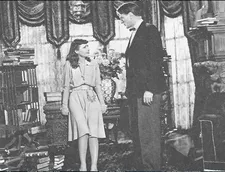 |
| Barbara Stanwyck with Gary Cooper in Ball Of Fire, directed by Howard Hawks |
JS: I was really shocked and very saddened.
AKT: So was I. Thank you for this conversation today!
JS: Thank you so much, Anne-Katrin!
Coming up - James Sanders on Manhattan, Annie Hall and apartment sounds; The Seven Year Itch, The Apartment, Breakfast At Tiffany’s and how certain stories can only happen in certain locations that are built to bring us together or keep us apart; producer Jeremy Thomas, Jonathan Coe’s Mr. Wilder And Me, and Billy Wilder never being a New Yorker; the office building and The Best Of Everything; Butterfield 8 and the canopy; Do The Right Thing and the stoop, plus more on urban life and the movies.
Renewing The Dream: The Mobility Revolution And The Future Of Los Angeles event is at Rizzoli, 1133 Broadway (at 26th Street) in New York. RSVPs are encouraged but not required. Seating is limited and will be first come, first served. Doors open at 5:30 pm.





















